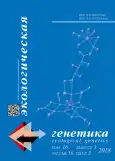Haplotypic diversity of mosquitoes of the genus Anopheles (Diptera, Culicidae) of North Vietnam
- Authors: Vu T.1, Andrianov B.V.2, Gorelova T.V.2, Gordeev M.I.1
-
Affiliations:
- Moscow Region State University
- Vavilov Institute of General Genetics Russian Academy of Sciences
- Issue: Vol 16, No 3 (2018)
- Pages: 18-25
- Section: Genetic basis of ecosystems evolution
- URL: https://journals.rcsi.science/ecolgenet/article/view/8963
- DOI: https://doi.org/10.17816/ecogen16318-25
- ID: 8963
Cite item
Full Text
Abstract
Background. Malaria in the territory of North Vietnam remains an actual problem. The species composition of mosquitoes of the genus Anopheles – the main vectors of malaria and the density of their populations – has a critical impact on the likelihood of the epidemic.
Materials and methods. We analyzed the variability of the BOLD fragment of the mitochondrial cox1 gene in a sampling set of Anopheles mosquitoes from the North Vietnam. Results. We found mosquitoes belonging to the species complexes: Anopheles sinensis, Anopheles vagus and Anopheles barbirostris. Nucleotide variability within the complexes does not exceed 2%. The differentiation into subspecies within the species complexes was not found.
Conclusion. The most common species of the genus Anopheles of North Vietnam is Anopheles sinensis — the main malaria vector. We predict the success of local transmission of malaria in this region in the case of malaria emergence.
Keywords
Full Text
##article.viewOnOriginalSite##About the authors
Thi Huong Vu
Moscow Region State University
Author for correspondence.
Email: Vuhuongmgou@gmail.com
Researcher
Russian Federation, 24, Very Voloshinoy street, Mytishi, 141014Boris V. Andrianov
Vavilov Institute of General Genetics Russian Academy of Sciences
Email: andrianovb@mail.ru
ORCID iD: 0000-0002-0064-4696
PhD, Senior Researcher
Russian Federation, 3, Gubkin street, Moscow, 119991Tatiana V. Gorelova
Vavilov Institute of General Genetics Russian Academy of Sciences
Email: tagor08@mail.ru
PhD, Researcher
Russian Federation, 3, Gubkin street, Moscow, 119991Michail I. Gordeev
Moscow Region State University
Email: gordeev_mikhail@mail.ru
PhD, Head of the Department
Russian Federation, 24, Very Voloshinoy street, Mytishi, 141014References
- Fang Y, Shi WQ, Zhang Y. Molecular phylogeny of Anopheles hyrcanus group members based on ITS2 rDNA. Parasit Vectors. 2017;10(1):417. doi: 10.1186/s13071-017-2351-x.
- Fang Y, Shi WQ, Zhang Y. Molecular phylogeny of Anopheles hyrcanus group (Diptera: Culicidae) based on mtDNA COI. Infect Dis Poverty. 2017;6(1):61. doi: 10.1186/s40249-017-0273-7.
- Zhang HG, Lv MH, Yi WB, et al. Species diversity can be overestimated by a fixed empirical threshold: insights from DNA barcoding of the genus Cletus (Hemiptera: Coreidae) and the meta-analysis of COI data from previous phylogeographical studies. Mol Ecol Resour. 2017;17(2):314-323. doi: 10.1111/1755-0998.12571.
- Hebert PD, Cywinska A, Ball SL, deWaard JR. Biological identifications through DNA barcodes. Proc Biol Sci. 2003;270(1512):313-321. doi: 10.1098/rspb.2002.2218.
- Khrabrova NV, Andreeva YV, Sibataev AK, et al. Mosquitoes of Anopheles hyrcanus (Diptera, Culicidae) Group: Species Diagnostic and Phylogenetic Relationships. Am J Trop Med Hyg. 2015;93(3):619-622. doi: 10.4269/ajtmh.14-0207.
- Wang G, Li C, Guo X, et al. Identifying the main mosquito species in China based on DNA barcoding. PLoS One. 2012;7(10): e47051. doi: 10.1371/journal.pone.0047051.
- Cywinska A, Hunter FF, Hebert PD. Identifying Canadian mosquito species through DNA barcodes. Med Vet Entomol. 2006;20(4):413-424. doi: 10.1111/j.1365-2915.2006.00653.x.
- Chan A, Chiang LP, Hapuarachchi HC, et al. DNA barcoding: complementing morphological identification of mosquito species in Singapore. Parasit Vectors. 2014;7:569. doi: 10.1186/s13071-014-0569-4.
- Feng X, Huang L, Lin L, et al. Genetic diversity and population structure of the primary malaria vector Anopheles sinensis (Diptera: Culicidae) in China inferred by cox1 gene. Parasit Vectors. 2017;10(1):75. doi: 10.1186/s13071-017-2013-z.
- Choochote W, Min GS, Intapan PM, et al. Evidence to support natural hybridization between Anopheles sinensis and Anopheles kleini (Diptera: Culicidae): possibly a significant mechanism for gene introgression in sympatric populations. Parasit Vectors. 2014;7:36. doi: 10.1186/1756-3305-7-36.
- Liang J, Sharakhova MV, Lan Q, et al. A standard cytogenetic map for Anopheles sinensis and chromosome arm homology between the subgenera Anopheles and Cellia. Med Vet Entomol. 2014;28 Suppl 1:26-32. doi: 10.1111/mve.12048.
- Liang J, Cheng B, Zhu G, et al. Structural divergence of chromosomes between malaria vectors Ano pheles lesteri and Anopheles sinensis. Parasit Vectors. 2016;9(1):608. doi: 10.1186/s13071-016-1855-0.
- Dhiman S, Yadav K, Rabha B, et al. Evaluation of Insecticides Susceptibility and Malaria Vector Potential of Anopheles annularis s. l. and Anopheles vagus in Assam, India. PLoS One. 2016;11(3): e0151786. doi: 10.1371/journal.pone.0151786.
- Маниатис Т., Фрич Э., Сэмбрук Дж. Методы генетической инженерии. Молекулярное клонирование. – М.: Мир, 1984. [Maniatis T, Fritch EF, Sambrook J. Molecular cloning. Moscow: Mir; 1984. (In Russ.)]
- Sinka ME, Bangs MJ, Manguin S, et al. The dominant Anopheles vectors of human malaria in the Asia-Pacific region: occurrence data, distribution maps and bionomic precis. Parasit Vectors. 2011;4:89. doi: 10.1186/1756-3305-4-89.
- Folmer O, Black M, Hoeh W, et al. DNA primers for amplification of mitochondrial cytochrome c oxidase subunit I from diverse metazoan invertebrates. Mol Mar Biol Biotechnol. 1994;3(5):294-299.
- Kumar S, Stecher G, Tamura K. MEGA7: Molecular Evolutionary Genetics Analysis Version 7.0 for Bigger Datasets. Mol Biol Evol. 2016;33(7):1870-1874. doi: 10.1093/molbev/msw054.
- Leigh JW, Bryant D, Nakagawa S. popart: full-feature software for haplotype network construction. Methods Ecol Evol. 2015;6(9):1110-1116. doi: 10.1111/2041-210x.12410.
- Clement M, Posada D, Crandall KA. TCS: a computer program to estimate gene genealogies. Mol Ecol. 2000;9(10):1657-1659. doi: 10.1046/j.1365-294x.2000.01020.x.
- Gu ZC, Shang LY, Chen JS, et al. The role of Anopheles anthropophagus in malaria transmission in Xinyang City of Henan Province. Zhongguo Ji Sheng Chong Xue Yu Ji Sheng Chong Bing Za Zhi. 2001;19(4):221-224.
- Zhu G, Xia H, Zhou H, et al. Susceptibility of Ano pheles sinensis to Plasmodium vivax in malarial outbreak areas of central China. Parasit Vectors. 2013;6:176. doi: 10.1186/1756-3305-6-176.
Supplementary files








